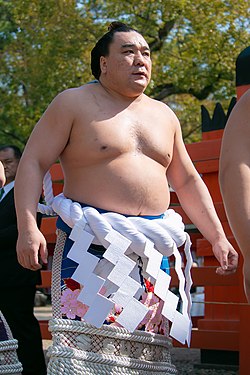B

- Banzuke (番付)
- List of sumo wrestlers according to rank for a particular grand tournament, reflecting changes in rank due to the results of the previous tournament. It is written out in a particular calligraphy (see sumō-ji ) and usually released on the Monday 13 days prior to the first day of the tournament.
- Banzuke-gai (番付外)
- 'Outsider to the list'. A wrestler who is not yet ranked, or has fallen off the banzuke due to injury or other reason for non-participation. [3]
- Bariki (馬力)
- 'Vigour'. Cryptic term linking the consumption of alcohol to the strength of the wrestlers, as being alcohol resistant is said to be a show of power. In the past, wrestlers would pour beer or sake into a bowl the same size as a rice bowl and eat chanko while drinking. Today, the consumption of alcohol is an integral part of the celebration after a wrestler wins a tournament, as he drinks sake from a big rice wine cup (sakazuki).
- Basho (場所)
- 'Venue'. Any sumo tournament. Compare honbasho .
- Binbōgami (貧乏神)
- 'God of poverty'. In sumo ranking, the top jūryō wrestlers. Top jūryō wrestlers are often called to bout with makuuchi wrestlers, but their income stays at that of a jūryō.
- Binzuke (鬢付け)
- Also called binzuke abura ('binzuke oil'). A Japanese pomade, which consists mainly of wax and hardened chamomile oil that was used to style sumo wrestlers' hair and give it its distinctive smell and sheen. It is used exclusively by tokoyama hairdressers.
- Butsukari (ぶつかり)
- 'Collision'. A junior wrestler pushes a more senior wrestler (in a resistance position and presenting his torso) with force across the dohyō in order to build strength and learn hand placement. A demanding exercise that is repeated until exhaustion.

















